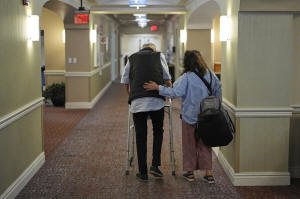Nursing homes struggle with Trump's immigration crackdown
[July 14, 2025]
By MATT SEDENSKY
NEW YORK (AP) — Nursing homes already struggling to recruit staff are
now grappling with President Donald Trump’s attack on one of their few
reliable sources of workers: immigration.
Facilities for older adults and disabled people are reporting the
sporadic loss of employees who have had their legal status revoked by
Trump. But they fear even more dramatic impacts are ahead as pipelines
of potential workers slow to a trickle with an overall downturn in legal
immigration.
“We feel completely beat up right now,” says Deke Cateau, CEO of A.G.
Rhodes, which operates three nursing homes in the Atlanta area, with
one-third of the staff made up of foreign-born people from about three
dozen countries. “The pipeline is getting smaller and smaller.”
Eight of Cateau’s workers are expected to be forced to leave after
having their Temporary Protected Status, or TPS, revoked. TPS allows
people already living in the U.S. to stay and work legally if their home
countries are unsafe due to civil unrest or natural disasters and during
the Biden administration, the designation was expanded to cover people
from a dozen countries, including large numbers from Venezuela and
Haiti.
While those with TPS represent a tiny minority of A.G. Rhodes' 500
staffers, Cateau says they will be “very difficult, if not impossible,
to replace” and he worries what comes next.
“It may be eight today, but who knows what it’s going to be down the
road,” says Cateau, an immigrant himself, who arrived from Trinidad and
Tobago 25 years ago.

Nearly one in five civilian workers in the U.S. is foreign born,
according to the Bureau of Labor Statistics, but as in construction,
agriculture and manufacturing, immigrants are overrepresented in
caregiving roles. More than a quarter of an estimated 4 million nursing
assistants, home health aides, personal care aides and other so-called
direct care workers are foreign born, according to PHI, a nonprofit
focused on the caregiving workforce.
The aging of the massive Baby Boom generation is poised to fuel even
more demand for caregivers, both in institutional settings and in
individuals' homes. BLS projects more growth among home health and
personal care aides than any other job, with some 820,000 new positions
added by 2032.
Nursing homes, assisted living facilities, home health agencies and
other such businesses were counting on immigrants to fill many of those
roles, so Trump's return to the White House and his administration's
attack on nearly all forms of immigration has sent a chill throughout
the industry.
Katie Smith Sloan, CEO of LeadingAge, which represents nonprofit care
facilities, says homes around the country have been affected by the
immigration tumult. Some have reported employees who have stopped coming
to work, fearful of a raid, even though they are legally in the country.
Others have workers who are staying home with children they have kept
out of school because they worry about roundups. Many others see a
slowdown of job applicants.
“This is just like a punch in the gut,” she says.
Rachel Blumberg, CEO of the Toby and Leon Cooperman Sinai Residences in
Boca Raton, Florida, has already lost 10 workers whose permission to
stay in the U.S. came under a program known as humanitarian parole,
which had been granted to people from Cuba, Haiti, Nicaragua and
Venezuela. She is slated to lose 30 more in the coming weeks with the
end of TPS for Haitians.
“I think it’s the tip of the iceberg,” says Blumberg, forecasting
further departures of employees who may not themselves be deported, but
whose spouse or parent is.

Blumberg got less than 24 hours’ notice when her employees lost their
work authorization, setting off a scramble to fill shifts. She has
already boosted salaries and referral bonuses but says it will be
difficult to replace not just aides, but maintenance workers,
dishwashers and servers.
“Unfortunately, Americans are not drawn to applying and working in the
positions that we have available,” she says.
[to top of second column]
|

People walk inside the assisted living facility at the Toby and Leon
Cooperman Sinai Residences, July 4, 2025, in Boca Raton, Fla. (AP
Photo/Rebecca Blackwell)

Front-line caregivers are overwhelmingly female and a majority are
members of minority groups, according to PHI, earning an average of
just $16.72 hourly in 2023.
Long-term care homes saw an exodus of workers as COVID made an
already-challenging workplace even more so. Some facilities were
beginning to see employment normalize to pre-pandemic levels just as
the immigration crackdown hit, though industry-wide, there is still
a massive shortage of workers.
Some in the industry have watched in frustration as Trump lamented
how businesses including farming and hospitality could be hurt by
his policies, wondering why those who clean hotel rooms or pick
tomatoes deserve more attention than those who care for elders.
Beyond rescinded work authorizations for people living in the U.S.,
care homes are having difficulty getting visas approved for
registered nurses and licensed practical nurses they recruit abroad.
What used to be a simple process now stretches so long that
candidates reconsider the U.S. altogether, says Mark Sanchez, chief
operating officer of United Hebrew, a nursing home in New Rochelle,
New York.
“There are lines upon lines upon lines,” says Sanchez, “and now
they’re saying, ‘I’m going to go to Canada’ and ‘I’m going to go to
Germany and they’re welcoming me with open arms.’”
Looking around a facility with a majority-immigrant staff, the son
of Filipino immigrants wonders where his future recruits will come
from.
“I don’t have ICE coming in my door and taking my people,” Sanchez
says, “but the pipeline that was flowing before is now coming in
dribs and drabs.”
Long-term care workers are routinely lured away not just by
hospitals and doctors’ offices, but restaurants, stores and
factories. Half of the average nursing home’s staff turns over each
year, according to federal data, making the attraction and retention
of every employee vital to their operation.

Robin Wolzenburg of LeadingAge in Wisconsin began working to place
an influx of people from Afghanistan after the U.S. pulled out its
final troops four years ago and thousands of refugees arrived in her
state. Care homes began hiring the refugees and were so delighted
with them, some facilities began hiring refugees who arrived from
Ukraine, Somalia and Congo. Though many homes had employee retention
rates around 30%, Wolzenburg said the figure was above 90% with
refugees.
Trump has halted most refugee admissions, meaning Wolzenburg's
successful outreach program has no new arrivals to target.
“It’s been really devastating,” Wolzenburg says. “Our communities
that were actively working with the resettlement agencies are not
seeing those referrals to long-term care like we were. There’s no
refugees coming in.”
Lynne Katman, the founder of Juniper Communities, which runs 21
facilities across five states, says it’s hard enough to find the
right workers with a passion for older adults. Now, just as homes
gird for an influx of residents brought on by the country’s
demographic shift, they’re facing another challenge to a stable
workforce.
“The work is hard. It’s not always been the highest paying job that
one can get,” she says. “But many of the immigrants who actually
have chosen this work consider caregiving a noble profession.”
All contents © copyright 2025 Associated Press. All rights reserved |